Great Astronomers by Robert Stawell Ball (uplifting novels .txt) 📕
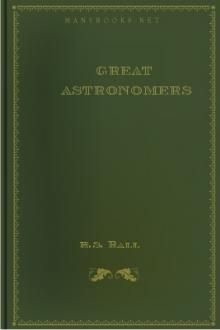
- Author: Robert Stawell Ball
- Performer: -
Book online «Great Astronomers by Robert Stawell Ball (uplifting novels .txt) 📕». Author Robert Stawell Ball
considered to be a fair passage in those days, he landed in Table
Bay, and having duly reconnoitred various localities, he decided
to place his observatory at a place called Feldhausen, about six
miles from Cape Town, near the base of the Table Mountain. A
commodious residence was there available, and in it he settled
with his family. A temporary building was erected to contain the
equatorial, but the great twenty-foot telescope was accommodated
with no more shelter than is provided by the open canopy of
heaven.
As in his earlier researches at home, the attention of the great
astronomer at the Cape of Good Hope was chiefly directed to the
measurement of the relative positions and distances apart of the
double stars, and to the close examination of the nebulae. In the
delineation of the form of these latter objects Herschel found
ample employment for his skilful pencil. Many of the drawings he
has made of the celestial wonders in the southern sky are
admirable examples of celestial portraiture.
The number of the nebulae and of those kindred objects, the star
clusters, which Herschel studied in the southern heavens, during
four years of delightful labour, amount in all to one thousand
seven hundred and seven. His notes on their appearance, and the
determinations of their positions, as well as his measurements of
double stars, and much other valuable astronomical research, were
published in a splendid volume, brought out at the cost of the
Duke of Northumberland. This is, indeed, a monumental work, full
of interesting and instructive reading for any one who has a
taste for astronomy.
Herschel had the good fortune to be at the Cape on the occasion of
the periodical return of Halley’s great comet in 1833. To the
study of this body he gave assiduous attention, and the records of
his observations form one of the most interesting chapters in that
remarkable volume to which we have just referred.
[PLATE: COLUMN AT FELDHAUSEN, CAPE TOWN, to commemorate Sir John
Herschel’s survey of the Southern Heavens.]
Early in 1838 Sir John Herschel returned to England. He had made
many friends at the Cape, who deeply sympathised with his self-imposed labours while he was resident among them. They desired to
preserve the recollection of this visit, which would always, they
considered, be a source of gratification in the colony.
Accordingly, a number of scientific friends in that part of the
world raised a monument with a suitable inscription, on the
spot which had been occupied by the great twenty-foot reflector at
Feldhausen.
His return to England after five years of absence was naturally
an occasion for much rejoicing among the lovers of astronomy. He
was entertained at a memorable banquet, and the Queen, at her
coronation, made him a baronet. His famous aunt Caroline, at that
time aged eighty, was still in the enjoyment of her faculties, and
was able to estimate at its true value the further
lustre which was added to the name she bore. But there is reason
to believe that her satisfaction was not quite unmixed with
other feelings. With whatever favour she might regard her nephew,
he was still not the brother to whom her life had been devoted.
So jealous was this vigorous old lady of the fame of the great
brother William, that she could hardly hear with patience of the
achievements of any other astronomer, and this failing existed in
some degree even when that other astronomer happened to be her
illustrious nephew.
With Sir John Herschel’s survey of the Southern Hemisphere it may
be said that his career as an observing astronomer came to a close.
He did not again engage in any systematic telescopic research.
But it must not be inferred from this statement that he desisted
from active astronomical work. It has been well observed that Sir
John Herschel was perhaps the only astronomer who has studied with
success, and advanced by original research, every department of
the great science with which his name is associated. It was to
some other branches of astronomy besides those concerned with
looking through telescopes, that the rest of the astronomer’s life
was to be devoted.
To the general student Sir John Herschel is best known by the
volume which he published under the title of “Outlines of
Astronomy.” This is, indeed, a masterly work, in which the
characteristic difficulties of the subject are resolutely faced
and expounded with as much simplicity as their nature will admit.
As a literary effort this work is admirable, both on account of
its picturesque language and the ennobling conceptions of the
universe which it unfolds. The student who desires to become
acquainted with those recondite departments of astronomy, in which
the effects of the disturbing action of one planet upon the
motions of another planet are considered, will turn to the
chapters in Herschel’s famous work on the subject. There he will
find this complex matter elucidated, without resort to difficult
mathematics. Edition after edition of this valuable work has
appeared, and though the advances of modern astronomy have left it
somewhat out of date in certain departments, yet the expositions
it contains of the fundamental parts of the science still remain
unrivalled.
Another great work which Sir John undertook after his return from
the Cape, was a natural climax to those labours on which his
father and he had been occupied for so many years. We have
already explained how the work of both these observers had been
mainly devoted to the study of the nebulae and the star clusters.
The results of their discoveries had been announced to the world
in numerous isolated memoirs. The disjointed nature of these
publications made their use very inconvenient. But still it was
necessary for those who desired to study the marvellous objects
discovered by the Herschels, to have frequent recourse to the
original works. To incorporate all the several observations of
nebular into one great systematic catalogue, seemed, therefore, to
be an indispensable condition of progress in this branch of
knowledge. No one could have been so fitted for this task as Sir
John Herschel. He, therefore, attacked and carried through the
great undertaking. Thus at last a grand catalogue of nebulae and
clusters was produced. Never before was there so majestic an
inventory. If we remember that each of the nebulae is an object
so vast, that the whole of the solar system would form an
inconsiderable speck by comparison, what are we to think of a
collection in which these objects are enumerated in thousands? In
this great catalogue we find arranged in systematic order all the
nebulae and all the clusters which had been revealed by the
diligence of the Herschels, father and son, in the Northern
Hemisphere, and of the son alone in the Southern Hemisphere. Nor
should we omit to mention that the labours of other astronomers
were likewise incorporated. It was unavoidable that the
descriptions given to each of the objects should be very slight.
Abbreviations are used, which indicate that a nebula is bright, or
very bright, or extremely bright, or faint, or very faint, or
extremely faint. Such phrases have certainly but a relative and
technical meaning in such a catalogue. The nebulae entered as
extremely bright by the experienced astronomer are only so
described by way of contrast to the great majority of these
delicate telescopic objects. Most of the nebulae, indeed, are so
difficult to see, that they admit of but very slight description.
It should be observed that Herschel’s catalogue augmented the
number of known nebulous objects to more than ten times that
collected into any catalogue which had ever been compiled before
the days of William Herschel’s observing began. But the study of
these objects still advances, and the great telescopes now in use
could probably show at least twice as many of these objects as are
contained in the list of Herschel, of which a new and enlarged
edition has since been brought out by Dr. Dreyer.
One of the best illustrations of Sir John Herschel’s literary
powers is to be found in the address which he delivered at the
Royal Astronomical Society, on the occasion of presenting a medal
to Mr. Francis Baily, in recognition of his catalogue of stars.
The passage I shall here cite places in its proper aspect the true
merit of the laborious duty involved in such a task as that which
Mr. Baily had carried through with such success:—
“If we ask to what end magnificent establishments are maintained
by states and sovereigns, furnished with masterpieces of art, and
placed under the direction of men of first-rate talent and high-minded enthusiasm, sought out for those qualities among the
foremost in the ranks of science, if we demand QUI BONO? for
what good a Bradley has toiled, or a Maskelyne or a Piazzi has
worn out his venerable age in watching, the answer is—not to
settle mere speculative points in the doctrine of the universe;
not to cater for the pride of man by refined inquiries into the
remoter mysteries of nature; not to trace the path of our system
through space, or its history through past and future eternities.
These, indeed, are noble ends and which I am far from any thought
of depreciating; the mind swells in their contemplation, and
attains in their pursuit an expansion and a hardihood which fit it
for the boldest enterprise. But the direct practical utility of
such labours is fully worthy of their speculative grandeur. The
stars are the landmarks of the universe; and, amidst the endless
and complicated fluctuations of our system, seem placed by its
Creator as guides and records, not merely to elevate our minds by
the contemplation of what is vast, but to teach us to direct our
actions by reference to what is immutable in His works. It is,
indeed, hardly possible to over-appreciate their value in this
point of view. Every well-determined star, from the moment its
place is registered, becomes to the astronomer, the geographer,
the navigator, the surveyor, a point of departure which can never
deceive or fail him, the same for ever and in all places, of a
delicacy so extreme as to be a test for every instrument yet
invented by man, yet equally adapted for the most ordinary
purposes; as available for regulating a town clock as for
conducting a navy to the Indies; as effective for mapping down the
intricacies of a petty barony as for adjusting the boundaries of
Transatlantic empires. When once its place has been thoroughly
ascertained and carefully recorded, the brazen circle with which
that useful work was done may moulder, the marble pillar may
totter on its base, and the astronomer himself survive only in the
gratitude of posterity; but the record remains, and transfuses
all its own exactness into every determination which takes it for
a groundwork, giving to inferior instruments—nay, even to
temporary contrivances, and to the observations of a few weeks or
days—all the precision attained originally at the cost of so much
time, labour, and expense.”
Sir John Herschel wrote many other works besides those we have
mentioned. His “Treatise on Meteorology” is, indeed, a standard
work on this subject, and numerous articles from the same pen on
miscellaneous subjects, which have been collected and reprinted,
seemed as a relaxation from his severe scientific studies. Like
certain other great mathematicians Herschel was also a poet, and
he published a translation of the Iliad into blank verse.
In his later years Sir John Herschel lived a retired life. For a
brief period he had, indeed, been induced to accept the office of
Master of the Mint. It was, however, evident that the routine of
such an occupation was not in accordance with his tastes, and he
gladly resigned it, to return to the seclusion of his
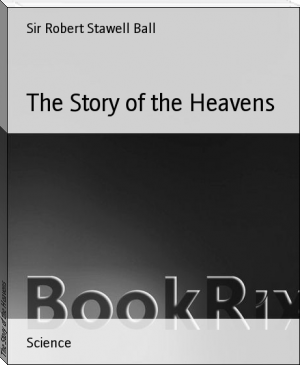
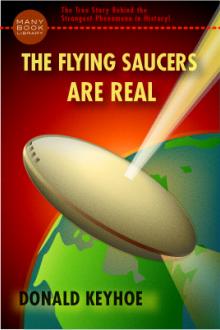

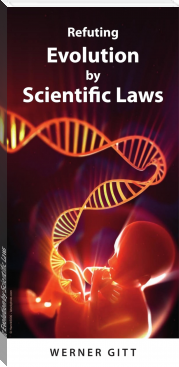
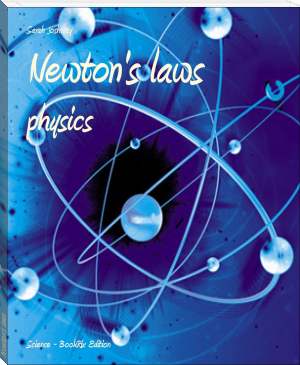
Comments (0)